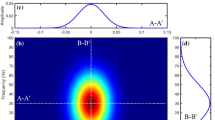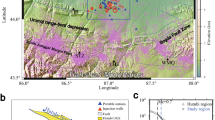Abstract
Since the favorable conditions of gas migration and accumulation in the deep Xujiahe formation of west Sichuan depression, a couple of high-yielding gas wells have been developed successfully, prime examples include X851, X856, X2, X3 and X10, which have confirmed the great exploration potential within the area. However, the appearance of some water production wells, such as CX565 and X201, has led to uncertainty within the reservoir prediction. Seismic signal based Time-frequency analysis has been used to distinguish the gas reservoir from water-bearing reservoir in Xujiahe formation. When the seismic wave propagates in the gas and water reservoir, it is difficult to identify the dynamic differences, in terms of amplitude, frequency and energy in the time field. Given that time-frequency analysis allows transformation of the seismic data from the time field into the time-frequency field, it is employed to highlight the seismic responses of gas reservoirs. Usually, the characteristics of ‘low-frequency shadows’ and ‘high-frequency attenuation’ are very obvious in gas reservoirs, while there is no such indication in water reservoirs, which can help to distinguish the gas reservoir from water reservoir. In this paper, we present the theoretical approaches and the in-situ model analyzing results, as well as, a case study. The application of time-frequency analysis on the deep Xujiahe formation in the western Sichuan Depression, provides robust indications for reservoir prediction of gas and water differentiation and validates investigation.








Similar content being viewed by others
References
Avijit C, Okaya D (1995) Frequency-time decomposition of seismic data using wavelet-based methods. Geophysics 60(6):1906–1916
Barnes AE (1993) Instantaneous spectral bandwidth and dominant frequency with applications to seismic reflection data. Geophysics 58(3):419–428
Bedrosian E (1963) On the quadrature approximation to the Hilbert transform of modulated signals. Proc IEEE 51:868–869
Castagna JP, Sun S, Siegfried RW (2003) Instantaneous spectral analysis: detection of low-frequency shadows associated with hydrocarbons. Lead Edge 22(2):120–127
Chen CS, Jeng Y (2011) Nonlinear data processing method for the signal enhancement of GPR data. J Appl Geophys 75(1):113–123
Cohen L (1995) Time-frequency analysis: theory and applications Prentice-Hall, New York, pp 22–34
Farge M (1992) Wavelet transforms and their applications to turbulence. Annu Rev Fluid Mech 24:395–457
Gan Q, Xu D, Tang J, Wang Y (2009) Seismic resolution enhancement for tight-sand gas reservoir characterization. J Geophys Eng 6(1):21–28
Gao JH, Wang WB, Zhu GM et al. (1996) On the choice of wavelet functions for seismic data processing. Chin J Geophys 39(3):392–400 (in Chinese)
Gao J, Li Y, Chen W (1998) On the instantaneous attribute analysis of seismic data via wavelet transform. In: 68th annual int meeting. SEG, expanded abstracts, pp 1084–1087
Gao J, Dong X, Wang W et al. (1999) Instantaneous parameter extraction via wavelet transform. IEEE Trans Geosci Remote Sens 37(2):867–870
Gao JH, Wu RS, Wang BJ (2001) A new type of analyzing wavelet best matching seismic wavelets and its applications extraction of the instantaneous spectrum bandwidth. Expanded abstracts of the technical program. In: SEG 71th annual meeting, pp 1937–1940
Gao JH et al. (2003) Generalized S transform and seismic response analysis of thin interbeds. Chin J Geophys 46(4):526–532
Gao JH, Wan T, Chen WC et al. (2006) Three parameter wavelet and its applications to seismic data processing. Chin J Geophys 49(6):1802–1812
Gao J, Wu Q, Chen W (2007) Instantaneous frequency analysis of seismic data in wavelet transform domain. Geophys Prospect Petroleum 46:534–540
Goloshubin GM, Bakulin AV (1998) Seismic reflectivity of a thin porous fluid saturated layer versus frequency. In: 68th annual international meeting, SEG, expanded abstracts, pp 976–979
Greg P, James G, Jone L (1999) Interpretational applications of spectral decomposition in reservoir characterization. Lead Edge 3:353–360
He Z, Xiong X, Bian L (2008) Numerical simulation of seismic low-frequency shadows and its application. J Appl Geophys 5(4):301–306
Hedlin K, Mewhort L, Margrave G (2001) Delineation of steam flood using seismic attenuation. In: 71st ann internat mtg: soc of expl geophys, pp 1572–1575
Hudson JA (1980) Overall properties of a cracked solid. Math Proc Camb Philos Soc 88:371–384
Hudson JA (1981) Wave speeds and attenuation of elastic waves in material containing cracks. Geophys J R Astron Soc 64:133–150
Lopez JA et al (1997) Identification of deltaic facies with 3-D seismic coherency and spectral decomposition cube. Abstract of Istanbul ’ 97 International Geophysical Conference and Exposition, pp 7–10
Mabsinha L, Stockwell R, Lowe R et al. (1997) Local s-spectrum analysis of 1-d and 2-d data[J]. Phys Earth Planet Inter 103(3):329–336
Mallat SG (1998) Wavelet tour of signal processing. Academic Press, New York
Satish S, Routh PS, Anno PD, Castagna JP (2005) Spectral decomposition of seismic data with continuous-wavelet transformation. Geophysics 70(6):19–25
Stockwell RG et al. (1996) Localization of the complex spectrum: the S-transform. IEEE Trans Signal Process 17(6):998–1001
Taner MT, Koehler F, Sheriff RE (1979) Complex seismic trace analysis. Geophysics 44(6):1041–1063
Tang J, Zhang S, Li X (2008) PP and PS seismic response from fractured tight gas reservoirs: a case study. J Geophys Eng 5(1):92–102
Xu T, Cheng B, Qian Z et al. (2011) Multi-scale frequency and absorption attributes of seismic signals. J Geophys Eng 8(3):457–463
Acknowledgements
This work was partially supported by the National Natural Science Foundation for Young Scholars (Grant No. 41204071), the Application Program of Science and Technology Department of Sichuan province, China (Grant No. 2013JY0060, 2010JY0111), the National High Technology Research and Development Program of China (Grant No. 2013AA064201), and Petrochemical Joint Fund to Support Key Projects (Grant No. U1262206). The authors would like to acknowledge Benedict Robbins (Edinburg Anisotropy Project, British Geological Survey, Edinburgh, UK) for valuable discussions and review of this manuscript, and anonymous reviewers for their detailed comments and suggestions. Special thanks also go to the Editor-in-Chief for his interest in this work and comments.
Author information
Authors and Affiliations
Corresponding author
Rights and permissions
About this article
Cite this article
Hongying, L., Bingjie, C., Zhongmin, S. et al. Gas and water reservoir differentiation by time-frequency analysis: a case study in southwest China. Acta Geod Geophys 48, 439–450 (2013). https://doi.org/10.1007/s40328-013-0031-7
Received:
Accepted:
Published:
Issue Date:
DOI: https://doi.org/10.1007/s40328-013-0031-7




